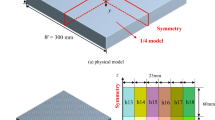Abstract—
A set of activities aimed at upgrading an experimental bench simulating heavily loaded components of thermonuclear facilities is accomplished. The design of a test section for implementing one-sided heating with high energy density is developed. A VCh-60AV high-frequency generator with operating frequencies of 30–60 kHz is the test section heating system’s key component. The article describes the experimental bench schematic design, hydraulic circuit components, and the high-frequency heating system and measurement system components. The schematic design of a hydraulic atomizer with a conical insert, which generates a sprayed flow in carrying out experimental studies is presented. The results of field velocity measurements in the atomizer spray jet and of experimental study of sprayed flow distribution over the droplet radius are given, and the average diameter of droplets in the spray jet section was determined, which was found to be 34 μm. The techniques for carrying out experiments on thermal stabilization in a steady mode by spray cooling and for processing the primary experimental data are described. The effectiveness of high-temperature surface thermal stabilization by a spray of distilled water at a coolant gauge pressure of (0.2–0.6) × 106 Pa, coolant mass flowrate (3.3–6.15) × 10–3 kg/s, and spray density within the range from 1.67 to 3.11 kg/(m2 s) is studied. The obtained experimental data array is processed, and the graphic dependences of heat flux and heat-transfer coefficient on the temperature difference between the cooled wall and coolant spray are presented. The heat flux in the experimental study reached 3.2 MW/m2, and the heat-transfer coefficient in that case was equal to 77 kW/(m2 K). The obtained experimental data show satisfactory repeatability in a wide range of temperature difference from 0 to 400°C, and high heat flux and heat-transfer values have been reached.













Similar content being viewed by others
REFERENCES
I. Mudawar, “Assessment of high heat-flux thermal management schemes,” IEEE Trans. Compon. Packag. Technol. 24, 122−141 (2001).
J. Kim, “Spray cooling heat transfer: The state of the art,” Int. J. Heat Fluid Flow 28, 753−767 (2007).
W.-L. Cheng, W.-W. Zhang, H. Chen, and L. Hu, “Spray cooling and flash evaporation cooling: the current development and application,” Renewable Sustainable Energy Rev. 55, 614−628 (2016).
M. R. Youssef, Modeling the Effect of a Spray on a Liquid Film on a Heated Surface (West Virginia Univ., Morgantown, W.Va., 2007).
R. Zhao, W. Cheng, Q. Liu, and H. Fan, “Study on heat transfer performance of spray cooling, model and analysis,” Heat Mass Transfer 46, 821−829 (2010).
I. V. Kazachkov, “Heat transfer and dynamics of the droplet on a superheated surface,” WSEAS Trans. Heat Mass Transfer 7, 47−57 (2012).
G. Liang and I. Mudawar, “Review of spray cooling. Part 1: Single-phase and nucleate boiling regimes, and critical heat flux,” Int. J. Heat Mass Transfer 115, 1174−1205 (2017).
R.-H. Chen, L. C. Chow, and J. E. Navedo, “Effects of spray characteristics on critical heat flux in subcooled water spray cooling,” Int. J. Heat Mass Transfer 45, 4033−4043 (2002).
I. Mudawar, “Determination of the local quench curve for spray-cooled metallic surfaces,” J. Heat. Treat. 7, 107−121 (1989).
M. R. Pais, L. C. Chow, and E. T. Mahefkey, “Surface roughness and its effects on the heat transfer mechanism in spray cooling,” J. Heat Transfer 114, 211−219 (1992).
V. S. Shteling, V. V. Il’in, A. T. Komov, and P. P. Shcherbakov, “Heat removal and thermal stabilization of high-temperature surfaces by a dispersed coolant flow,” Vestn. MEI, No. 5, 19−26 (2021).
B. G. Gordon, I. R. Ugoleva, and A. S. Grigor’ev, “Heat and mass transfer of a moving vapor–air mixture with water drops,” Teploenergetika, No. 6, 56−58 (1989).
I. R. Ugoleva, B. G. Gordon, and A. S. Grigor’ev, “Generalization of experimental data on heat and mass transfer of a moving vapor–air mixture with water drops,” Teploenergetika, No. 5, 45−51 (1989).
E. M. Bochkareva, V. V. Terekhov, and V. I. Terekhov, “Heat transfer during steam condensation on moving drops in emergency pressure relief systems at nuclear power plants,” in Proc. 6th Russian Natl. Conf on Heat Transfer (RNKT-6), Moscow, Russia, Oct. 27−31, 2014, pp. 1407−1410.
Funding
This work was financially supported by the Russian Science Foundation (agreement no. 21-79-10179).
Author information
Authors and Affiliations
Corresponding author
Ethics declarations
The authors declare that they have no conflicts of interest.
Additional information
Translated by V. Filatov
Rights and permissions
About this article
Cite this article
Shteling, V.S., Dedov, A.V., Zakharenkov, A.V. et al. An Experimental Study of Wall Thermal Stabilization Efficiency by Spray Cooling. Therm. Eng. 69, 954–962 (2022). https://doi.org/10.1134/S0040601522120072
Received:
Revised:
Accepted:
Published:
Issue Date:
DOI: https://doi.org/10.1134/S0040601522120072




